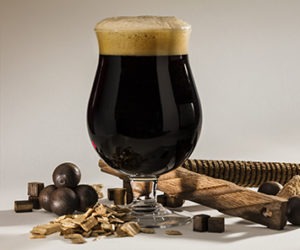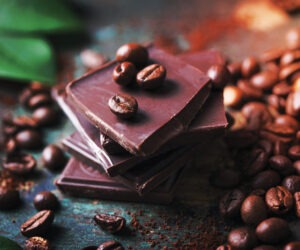Fruited Beer

At its core, beer really only needs three ingredients: Water, malt, and yeast. Hops were added later as a preservative and flavoring to beer, but many other ingredients were used to add flavor prior to hops. Certain fruit, such as grapes, were very commonly added to wort as a supplement in some cultures. Fruit can typically bring acidity, flavor, and some texture to beer. It’s no surprise then that fruit and beer are a match that can really stand out in a crowd. But there are certain pitfalls brewers can fall into that can doom a beer. Let’s take a spin through some basics of crafting a fruit beer.
Matching Beer with Fruit
The first and most important part of crafting a good fruit beer is to properly pair the base beer with the fruit. More delicate fruit should not be hidden by powerful roasted malt or other competing components. While chocolate-dipped strawberries may be delicious, strawberry flavors are quite mild and will easily be lost in stout. Sour beers, such as Berliner weisse or Gose, have recently become almost the default base for fruit beers. There is a very good reason for this as their acidity and non-confrontational flavors can really make the fruit aromas and flavors pop. Milkshake IPAs and pastry stouts are another more recent niche set of fruited beers.
Tropical fruits such as guava, passion fruit, and mango are often matched up with either lightly sour or fruity IPA base beers to produce beer with almost a cocktail- or dessert-like array of flavors. Berry fruits like blueberries and raspberries can also make a big impact with sour-style ales, but can also stand up nicely to beers such as blonde and amber ales. There is also a whole world of marrying grapes and beer as well. These hybrid beer-wine matches carry an amazing array of possibilities. Another notable fruit class is the stone fruits such as plum, cherry, and apricot. These fruits can be more expressive in their character and can stand up to some malt-forward beers.
A final nod goes to the pairing of citrus fruits with hop-forward beers. While tropical fruit can also pair well with New World hops with similar characteristics, matching citrus like grapefruit, orange, lemon, or lime with fruity hops like Centennial, Amarillo®, or Cascade can lift a beer’s profile. Using the zest or peels from citrus fruit is the most common, although some brewers will add the juice too. You just need to be careful with these additions as the acidity can overpower the beer easily.
Types of Fruit Additions
There are several different ways to approach adding fruit flavors. First is using fresh or frozen fruit. Even if you buy fresh fruit, many sources will advise you to freeze the fruit prior to adding it to beer. There are several sanitation steps you can take such as steaming the fruit, spraying the fruit with a metabisulfite solution (dissolved Campden tablets), or a spray or soak in cheap vodka. But if you are going to be drinking the beer fairly young, contamination should not be an issue. Also, try to make sure the fruit is submerged in the beer. Fruit floating on the surface can greatly encourage microbes to grow on them. They are safer in the harsher environment submerged in the beer.
Fruit floating on the surface can greatly encourage microbes to grow on them.
Buying aseptic juice (think not-from-concentrate orange juice) or big cans of fruit are two other available options. These juices are already pasteurized so you don’t need to sanitize and are often in a puree form. Fruits can also come in concentrated form, as extracts, or as natural flavorings. These can be especially helpful if you already added fresh fruit but didn’t get as much flavor as you desired. You can boost that character with an extract or flavoring.
Gravity Considerations
I will not go too deep down this rabbit hole as Mick Spencer wrote a great article on this topic in the BYO May-June 2021 issue titled, “Ciphering Fruit Beers.” But to paraphrase, and counter to most inclinations, most fruit additions will actually lower the potential alcohol content of your beer. The only exceptions may be in the case of low-alcohol beers like table beer as your base and/or in the case of using a very high sugar content fruit like grapes. Consider the case of raspberries, whose pulp’s gravity is a paltry 1.016. If you add 10 lbs. (4.5 kg) of raspberries to a beer, you are greatly watering the beer’s strength down. Wine grapes on the other hand may clock in over 1.100 . . . there is a reason grapes were so loved by many of our ancestors . . . that’s a lot more alcohol than raspberry wine.
Timing and Amounts
There is no right answer in this category, but generally fruit should be added after active fermentation has died down, possibly in secondary fermentation and off the yeast cake. This will allow the subtle fruit aromas a better chance of surviving into the final product. How much to add is highly dependent upon what you are after, either a subtle hint of fruit, or a big juicy-fruit blast. If using fresh or frozen fruit, a good starting point for many fruit types might be around 1 lb. per gallon (0.12 kg/L) of beer, but a big fruit bomb, 3–4 lbs. per gallon (0.36–0.48 kg/L) may be needed. But again, extracts and fruit flavors may be used as a supplement if the price tag and prep works seems daunting when looking to purchase 20 lbs. (9.1 kg) of mangos.
For a closer look at certain fruits and the characteristics along with recipes, please check out: https://byo.com/article/award-winning-fruit-beers/



